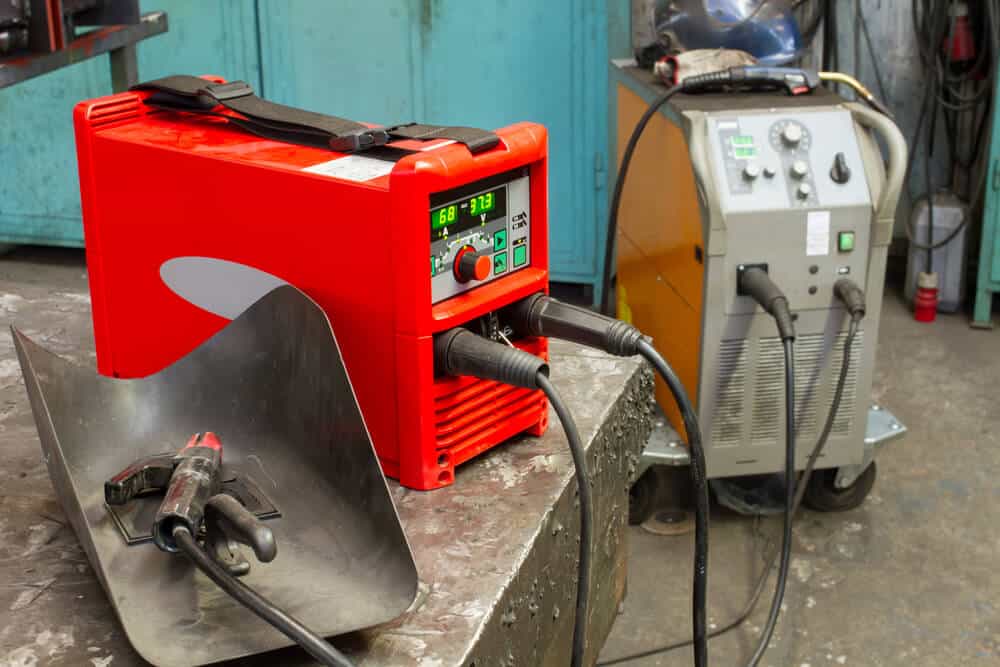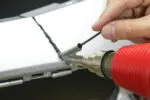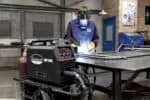Since the advancement in welding technologies, Inverter welding machines have become increasingly popular as they employ freshly developed silicon technology to control the welding process electrically.
It converts the main Alternating Current to Direct Current before raising the frequency of the current, such as 240V alternating current to 20V DC output.
Finally, it is rectified back to DC current and applied to the electrode.
An Inverter Welding Machine has several advantages, including being lightweight, small, portable, and simple to use. Because it uses relatively little electricity, it can be plugged into a standard household power outlet. It also has several power regulation settings and can handle low-quality electrical supply systems.
So what exactly is an inverter welding machine?
A welding equipment with an inverter transforms alternating current to a lower usable voltage output.
Inverter-based gadgets convert power using a couple of electrical components. Traditional transformer-based appliances, on the other hand, rely on a single huge transformer to manage the voltage.
This is accomplished through the use of electronic buttons that quickly turn on and off the electricity. The size of the transformer may be considerably reduced by controlling the power source before it enters the transformer.
An inverter is a voltage regulating electrical system. In the case of an inverter welding machine, it transforms the alternating current power source into a lower usable output voltage.
Inverter-based devices convert electricity using a succession of electronic components, as opposed to conventional transformer-based devices, which rely largely on a single massive transformer to manage voltage.
Let us get into the advantages of an Inverter Welding machine.
1.) Quality performance- Quality inverter-based welders outperform traditional welders in terms of performance, and this is notably obvious with stick welding, where operators find welding more simpler and do not have to fight the arc.
This is mostly due to inverter machines’ ability to have greater open circuit voltages and add features like anti-stick and arc-force.
Welding thin materials is a simple example of this as using a conventional stick welder is difficult, if not impossible, but with inverter machines, which have infinite amperage adjustment and a very stable arc, the output can be turned down very low so that it can weld a thin sheet metal with relative ease and control.
2.) Power Efficient- The machine may be connected to a domestic power supply outlet since its transformer consumes less power due to its modest size.
Therefore, you may execute the welding process while saving money on your power cost by using a standard supply socket.
Quality inverter machines will have an efficiency rating of around 80-90%, but traditional welders would have a far lower efficiency rating of around 50%.
This is because bigger transformers in typical machines have higher resistance and hence lose a substantial quantity of power and energy owing to heat dissipation.
3.) Good quality welds- We live in a world where welding precision is required in every location and on every material. In this tough world, inverter welders are beginning to shine.
Because inverter welders can be programmed to do anything, improved pulse MIG is now working in a manner akin to highly skilled TIG.
Software and improved electronics have opened up a world of possibilities that have radically altered the capabilities of a welding machine. It may even make an ordinary welder look really excellent at times.
An inverter welding equipment is the greatest choice for weld quality and innovation. Steel, on the other hand, may be kept basic.
4.) Lightweight and comfortable- Inverters are significantly smaller and lighter than transformers. A normal arc welder weighs more than 100 pounds, but a modern inverter weighs roughly 21 pounds.
Inverters, at one-fifth the weight of a typical welder, make travelling and storing your welder easier than ever before.
Inverters are suited for high-altitude applications and also for tight, compact places.
5.) Control Flexibility- The inverter welding machine contains electronic components that manage the power supply.
As a consequence, you may quickly make perfect welds that need precise parameters. This provides you more freedom during welding, depending on the material and type of weld required.
In some areas, the electrical supply might be highly erratic. Voltage fluctuations and frequency surges can frequently harm the delicate internal components of a welder, resulting in machine damage.
The inverter welder is more tolerant of such problems, preserving the components and guaranteeing that the welding arc stays unaffected.
6.) Cooling Capabilities
After several hours of welding, the interior components of welders can become extremely hot. The continual heat might cause parts to fail and reduce the welder’s lifespan.
Inverters, like desktop computers, have a cooling fan to protect the components from heat.
Since you have read about the advantages of Inverter welding machines, let us now hear about its disadvantages so that you can make an informed decision.
1.) Durability issues in inverter welding machines.
Although the inverter’s small size is useful when working off-site, it is not as durable as a big AC welder. Lightweight inverters are more prone to damage from a heavy drop or a dusty environment.
If your inverter becomes covered with airborne particles, such as those found in a grain silo, the machine’s internal circuitry may suffer damage.
2.) Inverter machines that are affordable are not always reliable.
As you may be aware, even the most affordable instrument will not last a lifetime. If you’re ready to spend more than $200, inverters are incredible equipment. The cheapest inverters are less than $80 and are cheaply built devices with few features.
If you’re lucky, you’ll be able to use a low-cost inverter for a few months before it dies.
The expense of repairing a low-priced model might equal half the machine’s worth. When shopping for inverters, invest in a high-quality unit that will endure for many years.
3.) Increased repair costs of inverter welding machines.
Some classic AC welders have been in use for over fifty years and are affordable and simple to repair. Inverters are more complicated, including software and circuitry not found in normal machines.
After your warranty expires, you’ll have to spend a bit more to have an inverter serviced. Extending your original warranty is one method to prevent expensive repair charges.
Some manufacturers provide the option to purchase an extended warranty at the time of purchase.
How do you use an inverter welding machine?
If you don’t know how to use inverter welding equipment, you may study the instructions or watch this YouTube video that tells you about its uses in detail-
Here are the steps you may take to master the fundamentals of using an inverter welding equipment:
1.) Plug the machine into a standard power outlet and attach the positive, negative, and ground wires to the work bed.
2.) Examine the tip of your welding gun to determine whether any metals fused with it during the previous phase.
3.) Put on your PPEs such as helmets, gloves, and safety shoes.
4.) Determine the parameters needed to weld the materials of your choosing.
5.) Clean the workpieces to be welded and arrange them close to each other.
6.) File the material away to make a V-shaped depression where they will be joined.
7.) Unidirectionally move the weld gun along the V to make the junction.
8.) Grind and file away the extra weld for a smooth, consistent finish.
FAQ
How long will an inverter welder last?
Inverter welders have a limited lifetime, and this can be reduced even further if they are not properly maintained and preserved.
This is because it contains more parts that can be easily destroyed if not properly cared for. An Inverter Welding equipment has a lifespan of 5-6 years.
Conclusion
Inverter welding equipment has seen tremendous evolution during the last 15 years. They are always working to improve both functionality and affordability.
However, this does not mean that we should bury transformer welding equipment, since they play an important role in the business as well.
If you’ve been using a normal AC welder for a while, you might want to test a new inverter type.
An inverter has various benefits over a typical machine, including the ability to pick any technique and personalise your arc for exceptional results.







